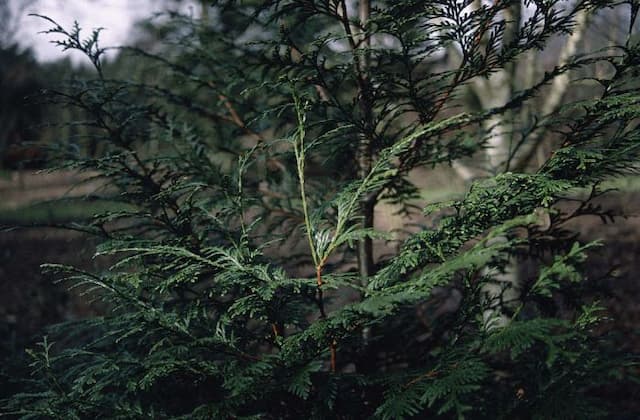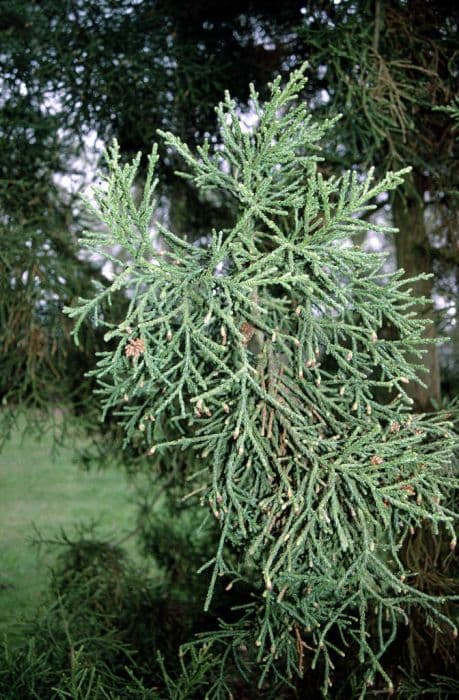China Fir Cunninghamia lanceolata











ABOUT
The plant commonly known as China fir has a distinctive appearance with its glossy green, lance-shaped leaves that are arranged in a spiral pattern along its branches. These leaves are sharp to the touch and can grow to a decent length, providing a dense foliage. The overall structure of the plant is conical, resembling a classic Christmas tree shape, with horizontal to slightly drooping branches that give it a full, tiered silhouette. It produces cones that are modest in size relative to the plant itself, adding a further textured aspect to its appearance. The bark of the China fir is another remarkable feature, often rough and divided into narrow ridges, giving it a rugged look. The color of the bark can be described as reddish-brown, providing a striking contrast with the bright green of the leaves. This plant can be characterized by its evergreen nature, ensuring that it maintains its vibrant coloration throughout the year, regardless of the season.
About this plant
 Names
NamesFamily
Cupressaceae.
Synonyms
China Fir, Chinese Cunninghamia, Chinese Fir.
Common names
Abies lanceolata, Belis jaculifolia, Cunninghamia jaculifolia, Cunninghamia konishii, Cunninghamia lanceolata var. konishii, Cunninghamia unicanaliculata, Pinus lanceolata.
 Toxicity
ToxicityTo humans
Cunninghamia lanceolata, commonly known as China fir, does not have a widespread reputation for being toxic to humans. If you suspect poisoning from any plant, it is crucial to consult a medical professional for proper diagnosis and treatment.
To pets
China fir is not generally known to be toxic to pets. However, ingestion of plant material by pets can sometimes cause gastrointestinal issues, such as vomiting or diarrhea, due to the non-digestible fibers or natural plant compounds. If you notice any adverse reactions in your pet after ingesting this plant, it is advisable to consult with a veterinarian.
 Characteristics
CharacteristicsLife cycle
Perennials
Foliage type
Evergreen
Color of leaves
Green
Height
40-60 feet (12-18 meters)
Spread
15-25 feet (4.5-7.5 meters)
Plant type
Tree
Hardiness zones
7
Native area
China
Benefits
 General Benefits
General Benefits- Durable Wood: Cunninghamia lanceolata, commonly known as China fir, has very durable wood that is resistant to rot and pests, making it ideal for construction, furniture, and outdoor applications.
- Timber Production: The fast growth of the China fir means it is a valuable species for timber plantations, providing a renewable source of wood for various uses.
- Ornamental Use: With its distinctive pyramid shape and evergreen foliage, the China fir is often used in landscaping and as a decorative tree in parks and gardens.
- Soil Stabilization: The extensive root system of the China fir helps to stabilize soil, making it useful for preventing erosion on slopes and in areas prone to landslides.
- Carbon Sequestration: Like many trees, China fir plays a role in capturing atmospheric carbon dioxide, thus contributing to the mitigation of climate change.
- Habitat Creation: China fir forests provide habitat and support biodiversity, offering a home to various species of birds, insects, and other wildlife.
- Shade and Shelter: The dense canopy of China fir trees provides shade and shelter, which can be beneficial for understory plants, animals, and human comfort in landscaped areas.
 Medical Properties
Medical Properties- Antibacterial: Cunninghamia lanceolata contains compounds that have been observed to exhibit antibacterial activity.
- Anti-inflammatory: There is evidence to suggest that extracts from the plant have anti-inflammatory properties.
- Antioxidant: The presence of certain phytochemicals indicates that Cunninghamia lanceolata may have antioxidant effects.
 Air-purifying Qualities
Air-purifying QualitiesThis plant is not specifically known for air purifying qualities.
 Other Uses
Other Uses- The wood of China fir is resistant to rot and termites, making it ideal for shipbuilding and other marine applications.
- In landscaping, China fir can be used to create hedges or screens due to its dense foliage and fast growth rate.
- Due to its straight grain and medium texture, China fir wood is used for making musical instruments such as soundboards for pianos and guitars.
- China fir's resin can be used in the production of fragrances and aromatics.
- The needles of the China fir are sometimes used to stuff traditional Chinese pillows and mattresses because they are thought to have a soothing fragrance and natural pest-resistant properties.
- The tree is often used in bonsai creation, offering aesthetic appeal and a challenge for bonsai enthusiasts due to its rapid growth.
- China fir needles can be used as mulch in gardens to retain soil moisture and reduce weed growth.
- Its dense timber is suitable for constructing outdoor furniture owing to its durability and resistance to decay.
- The species is planted for erosion control because its extensive root system stabilizes the soil efficiently.
- In rural areas, fallen China fir needles are gathered and used as livestock bedding because they are soft and readily available.
Interesting Facts
 Feng Shui
Feng ShuiThe China Fir is not used in Feng Shui practice.
 Zodiac Sign Compitability
Zodiac Sign CompitabilityThe China Fir is not used in astrology practice.
 Plant Symbolism
Plant Symbolism- Longevity: Cunninghamia lanceolata, commonly known as China Fir, often symbolizes long life due to its evergreen nature and ability to live for hundreds of years.
- Strength: The wood of the China Fir is highly valued for its strength and durability, which is why the tree is often associated with sturdiness and resilience.
- Adaptability: As the China Fir can thrive in a variety of soil types and climates, it represents adaptability and versatility in overcoming challenging conditions.
- Regeneration: The China Fir has a remarkable capacity for regrowth, symbolizing renewal and the ability to recover from adversity.
- Protection: In traditional landscaping, these trees were sometimes planted near homes, offering physical protection from the elements and symbolizing a safeguarding presence.
 Water
WaterThe China Fir should be watered deeply and thoroughly, ensuring that the soil is moist but not waterlogged. During the growing season, water the plant approximately once a week with about 1 to 1.5 gallons per watering session, depending on the size of the tree and the weather conditions. It is important to reduce the frequency of watering during the winter months when the tree is dormant. Always check the soil moisture level before watering; the top couple of inches of soil should be dry to the touch before adding more water. Overwatering can lead to root rot, so it's crucial to have well-draining soil.
 Light
LightChina Fir grows best in full sun but can also tolerate partial shade. The ideal spot for this plant is an area that receives at least 6 hours of direct sunlight daily. Avoid placing it in deep shade, as this can result in a less dense foliage and weaker growth.
 Temperature
TemperatureThe China Fir prefers temperate climates and can withstand minimum temperatures down to about 5°F. It thrives in a range of temperatures, though the ideal conditions are between 60°F and 80°F. The plant can survive brief exposures to lower temperatures but prolonged cold below the minimum can damage or kill it.
 Pruning
PruningPrune the China Fir to maintain its shape and remove any dead or damaged branches. The best time for pruning is in the late winter or early spring before the new growth starts. Pruning can be done annually, but it’s not always necessary every year. When pruning, make strategic cuts to enhance the natural pyramidal form of the tree and to promote healthy growth.
 Cleaning
CleaningAs needed
 Soil
SoilChina Fir prefers well-draining soil with a mix of sand, loam, and compost, at a pH of 5.0-7.0 for optimal growth.
 Repotting
RepottingChina Fir trees, being large and typically outdoor, do not require frequent repotting but may be planted in a larger space as they grow.
 Humidity & Misting
Humidity & MistingChina Fir tolerates a broad range of humidity levels and is generally not sensitive to variations as it is an outdoor plant.
 Suitable locations
Suitable locationsIndoor
China Fir needs space and light; not ideal for indoor growth due to size.
Outdoor
Plant China Fir in sunny spot with ample room for growth.
Hardiness zone
7-9 USDA
 Life cycle
Life cycleCunninghamia lanceolata, commonly known as China Fir, begins its life cycle as a seed that germinates in a suitable environment with enough moisture and warmth. The seedling emerges, developing a taproot and foliage as it grows into a young sapling. As the sapling matures, it undergoes a period of rapid growth, developing a conical shape with whorled branches and a straight trunk covered in reddish-brown bark. Photosynthesis in the scale-like leaves provides energy for further growth. The China Fir reaches reproductive maturity after several years, producing male and female cones on the same tree; the wind-pollinated male cones release pollen, which fertilizes the female cones. After fertilization, the female cones mature and release seeds, completing the life cycle and enabling the development of new plants.
 Propogation
PropogationPropogation time
Spring-summer
Propogation: The most popular method of propagating the Chinese fir, or Cunninghamia lanceolata, is through seed. The best time for sowing the seeds is typically in the spring, after the last frost when temperatures start to warm up. Seeds should be sown in a well-draining seed starting mix, covered lightly with soil, and kept moist until germination, which usually takes place within 3-4 weeks. Seedlings can then be grown on in pots before being transplanted outdoors when they are sturdy enough to withstand the elements. This is usually done after a couple of growing seasons when the seedlings have reached a height of 6-12 inches (15-30 centimeters), ensuring they are strong enough to be planted in their final location.









